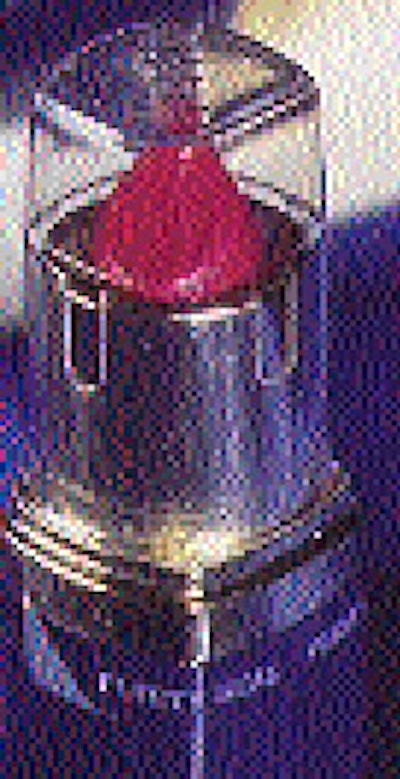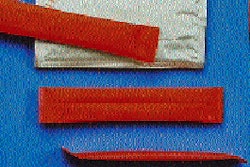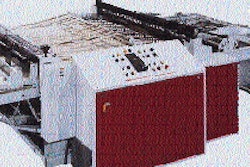The new inner cover on Maybelline's lipsticks has the word "discard" embossed in. It's obviously a throw-away part of the package. Yet, it seriously challenged the expertise of several companies well known for technology. In fact the cover has already been awarded a patent. As you read about this second-generation thermoformed cover for Memphis, TN-based Maybelline's lipsticks, the thermoformer, Plastofilm Industries (Wheaton, IL), is continuing to work on the third generation. The first cover from Plastofilm was described about 18 months ago (see PW, March '94, p. 16) and re-placed an injection-molded cover for lipsticks that are packaged in blister cards. This second version for uncarded lipsticks has been in use for nearly a year. It is an inner cover thermoformed of polyvinyl chloride that's deep-drawn from 27-mil sheet. Not only is the draw ratio a technical accomplishment, but Plastofilm has put together two trimming stations in-line with the thermoformer. The first cuts four tiny "windows" into the sides of each cover while it's still attached to the web. The second station cuts the covers from the web with tolerances so tight that even Plastofilm expressed concern. The "windows" are necessary so that the outside or opaque cover can slip over the inner cover and snap into position over the lipstick body. This prevents the movement of the lipstick swivel assembly. The result is a clear cover that protects the raised lipstick when the opaque cover is removed from the body of the lipstick. Many of Maybelline's lipsticks are now sold from a variety of countertop and wall displays that obviate the need for bulky blister packing. But without the protective blister, the cosmetics marketer needed something to safeguard the product from contamination and damage, while allowing the consumer to be able to see the color of the lipstick. That's a pretty tough set of requirements: product visibility, tamper-evidence, product protection, plus two others, reasonable economy and the ability to be automatically loaded in position on the production line, acknowledges Doug Lund, manager of design development, engineering for Maybelline. Less costly thermoforms The design for the new cover was in development for about a year, Lund says. "Originally, we started out with an injection-molded cover. Because of costs, we switched to PVC thermoforms," he says. "When it was injection molded, it was being produced on a 16-cavity mold. With Plastofilm doing the thermoforming, we use tooling with 96 cavities. So the economies of scale really helped us." Despite its experience with the earlier design, Plastofilm discovered this new one was even more challenging. "The previous thermoform was also a deep draw, but it had quite a nice taper to it. This one has virtually no taper, which adds dramatically to the molding and cutting complexity," says Gary Sowden, production manager at Plastofilm's Wheaton, IL, plant. However, it's the cutting of the tiny "windows" into the sides of the cover that is the real technical breakthrough. That and doing the forming and trimming all in-line. Plastofilm shares credit with its partners, Lyle Industries (Beaverton, MI), maker of the trim press, and with Edward Segen Co. (Milford, CT), the firm that designed and built the cutting dies. Plastofilm uses a vertical trim press from Lyle, one of the first of this type to be installed. To safeguard this technology, Plastofilm would not permit photography of the operation. "It's an extremely complicated process, and we all have made a huge investment in time, money and effort. It's an absolute deviation from what anyone else has done in the past," Sowden states. Tandem trimming "Plastofilm told us this is the most complicated punch system they've ever used. Some thermoformers don't believe this part can be produced, but Plastofilm is able to successfully trim this for us," Lund says in a mild boast. "The draw ratio is very large, plus we needed the windows. Overall, it required a totally new set of tooling." To produce the cover, Plastofilm married a thermoformer to the new Lyle vertical trim press and to another trim press. They worked with the tooling specialists from Segen who designed and built the matched-metal tools that cut the tiny windows and then retrieve the cut pieces by vacuum. "A big part of our engineering problem was to get all the cutting parts to fit within the space constraints," says Al Samson, president of Edward Segen Co. "There are lots of moving parts in a very small space. It was an exciting project for us because it's one of the first sophisticated uses of a vertical press and because there's so much going on in so little space." The tolerances required in the window cutting were far too tight to allow Plastofilm to use a conventional horizontal press, Sowden says. And to produce the kinds of volumes Maybelline needed, Plastofilm had to create an in-line system. Even the final trim station is more difficult to accomplish than simply cutting the thermoform from the web. The covers, Sowden says, require almost a zero flange cut, and there's very little of what he calls "lead-in" with the part. "Lead-in" is the use of previous cut covers to position the web for the next cycle. This final trim press does slightly nest the covers into stacks. The packer/inspectors remove the stacks from the press, inspect them and load them into boxes for shipment to Maybelline. In the packaging line, the company added a new robotic cover placer from Weckerle (Weilheim, Germany) that uses a turret-style magazine that accepts the stacks of covers right from the box. Adding the label The shade-conscious marketers at Maybelline realized that women shoppers would remove the opaque cap of uncarded lipsticks to see the color and gloss of the product in the store. Since the new inner cover could be easily pulled off the product in the store, Maybelline wanted a TE device to help guarantee the product hadn't been exposed to any contamination. This security is provided by a printed shrink label that's affixed where the inner cover rests on the lipstick body. From Avery Dennison (Framingham, MA), this label is 1.2-mil PVC film that's printed with a random legend, "Purity Seal." "There was a large learning curve on that label," Lund says, "particularly its size and adhesive. Since the label has a trailing edge, when you apply heat, it has a tendency to want to roll back on you. We experimented for months to get the right size and heat profile to get the label to perform the way we wanted." Under the direction of Brian Wilhoite, manager of the lipstick business unit, plant personnel at North Little Rock, AR, were responsible for extensive testing and modification to get the label and new equipment to perform well. Maybelline uses a label applicator from Avery, as well as Avery heat guns, both new additions to an already compact production line in the plant. Plastofilm is now working on the design of a new inner cap that will prevent the A-shell from rotating. Used with the TE label, this third generation cover could be used either for individual lipsticks or those packed into blister packs, Lund says. "We're trying to get to one cover that can be used for all our product," he concludes.
























